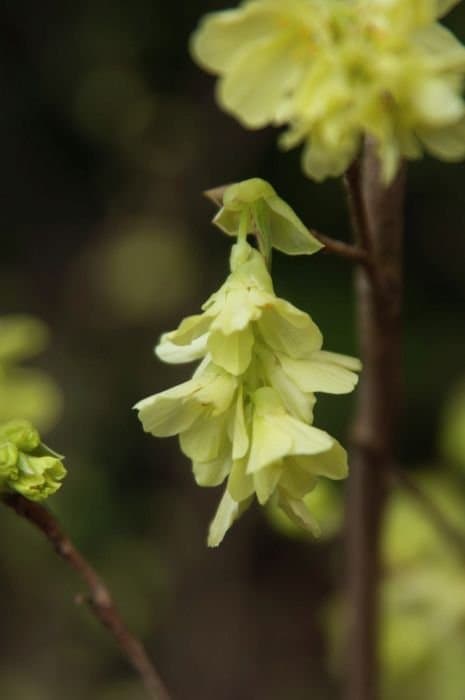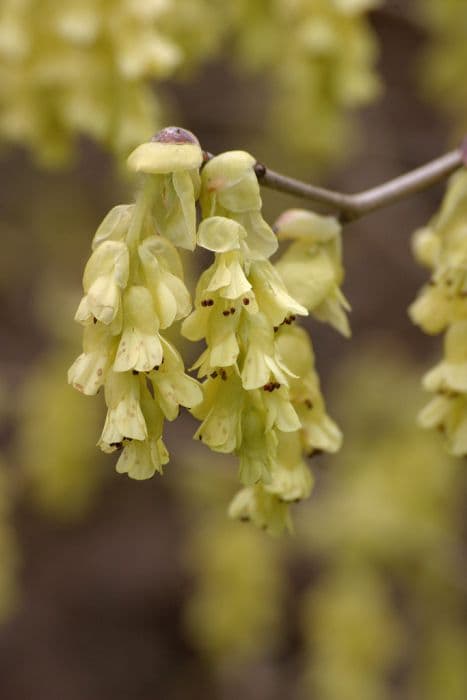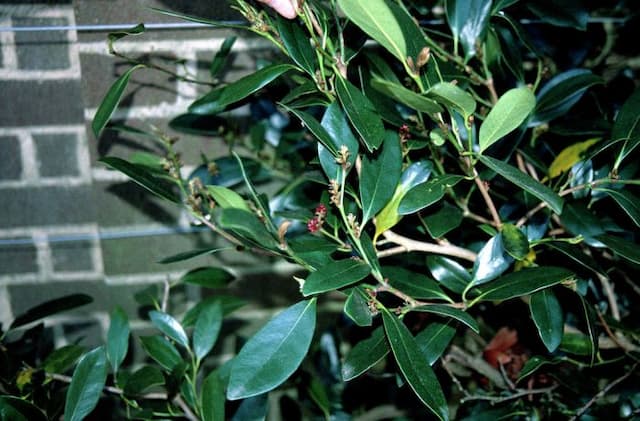Witch Hazel Hamamelis × intermedia 'Aphrodite'

ABOUT
The 'Aphrodite' witch hazel is an ornamental plant known for its striking appearance. It boasts large, spidery flowers that exude a bold orange color, capturing the attention of onlookers. These vibrant blooms typically appear in the late winter to early spring, creating a delightful contrast against the dreary backdrop of the season. The flowers of this witch hazel have a unique structure with ribbon-like petals that are slightly crinkled at the edges, giving them a delicate and intricate texture. In the center of each bloom, a cluster of reddish-brown calyx enhances the overall aesthetic with a touch of contrasting color. The foliage of the 'Aphrodite' witch hazel is also noteworthy. Leaves are broad, oval-shaped, and have a smooth edge. They exhibit a bright green color throughout the growing season, providing a lush backdrop for the radiant orange flowers. In the fall, the leaves undergo a transformation, showcasing an array of autumnal shades, from yellow to reddish-orange, before they eventually drop off as winter approaches. The branching of the 'Aphrodite' witch hazel is somewhat irregular, adding to its natural, picturesque quality. The plant's branches spread out and develop a pleasing, rounded shape that contributes to the overall visual appeal of the plant in a garden setting. Overall, the 'Aphrodite' witch hazel is celebrated for its striking flowers, attractive foliage, and distinctive branching, making it a desirable choice for those looking to add a splash of color to the late winter landscape.
About this plant
 Names
NamesFamily
Hamamelidaceae
Synonyms
Witch Hazel, Hybrid Witch Hazel, Winterbloom
Common names
Hamamelis × intermedia 'Aphrodite'.
 Toxicity
ToxicityTo humans
Witch hazel, including the cultivar Hamamelis × intermedia 'Aphrodite', is generally considered non-toxic to humans. There is no significant evidence that it causes poisoning when ingested in small amounts. However, consuming large quantities of plant material could potentially cause stomach upset due to the plant's astringent properties. To pets: Witch hazel, including the cultivar Hamamelis × intermedia 'Aphrodite', is similarly considered non-toxic to pets. There is no widespread report of toxicity in domestic animals such as dogs and cats. Just as with humans, ingestion in large amounts might cause mild gastrointestinal upset, but serious toxicity is not expected.
To pets
To humans: Witch hazel, including the cultivar Hamamelis × intermedia 'Aphrodite', is generally considered non-toxic to humans. There is no significant evidence that it causes poisoning when ingested in small amounts. However, consuming large quantities of plant material could potentially cause stomach upset due to the plant's astringent properties. Witch hazel, including the cultivar Hamamelis × intermedia 'Aphrodite', is similarly considered non-toxic to pets. There is no widespread report of toxicity in domestic animals such as dogs and cats. Just as with humans, ingestion in large amounts might cause mild gastrointestinal upset, but serious toxicity is not expected.
 Characteristics
CharacteristicsLife cycle
Perennials
Foliage type
Deciduous
Color of leaves
Green
Flower color
Orange
Height
8-12 feet (2.4-3.7 meters)
Spread
8-12 feet (2.4-3.7 meters)
Plant type
Shrub
Hardiness zones
5
Native area
Asia
Benefits
 General Benefits
General Benefits- Year-round interest: Provides vibrant flowers in winter and colorful foliage in fall.
- Attractive flowers: Unique orange-red flowers that are particularly striking when most other plants are dormant.
- Fragrance: Flowers have a subtle, sweet fragrance that can be a pleasant addition to the garden during their winter blooming period.
- Wildlife attraction: Supports local wildlife by providing nectar when few other food sources are available.
- Low maintenance: Requires minimal care once established, making it suitable for gardeners of all skill levels.
- Hardy: Tolerant of a range of temperatures and can withstand chilly winters.
- Drought resistance: Once established, it has good resistance to drought conditions.
- Erosion control: Can help to stabilize soil and prevent erosion in certain landscapes.
 Medical Properties
Medical PropertiesThis plant is not used for medical purposes.
 Air-purifying Qualities
Air-purifying QualitiesThis plant is not specifically known for air purifying qualities.
 Other Uses
Other Uses- Photography - The Witch Hazel 'Aphrodite' can be used as a subject for photography enthusiasts due to its vibrant, orange-red flowers that provide a striking contrast, especially in winter landscapes.
- Teaching Aid - This plant can be used in botany classes to demonstrate hybrid plant forms and the characteristics that hybrids may exhibit, such as flower color and blooming period.
- Dyeing Fabric - The tannins present in the leaves and bark of Witch Hazel 'Aphrodite' may be used for creating natural dyes for textiles, giving them a soft, earthy hue.
- Decorative Branches - The plant's distinctive architecture and stout branches make it ideal for use in decorative indoor arrangements and living art installations.
- Crafts - The seed pods and twigs can be used in making wreaths, garlands, or other rustic crafting projects for home decor.
- Erosion Control - The dense root system can be advantageous for stabilizing slopes and preventing soil erosion in landscape settings.
- Winter Garden Interest - Witch Hazel 'Aphrodite' provides visual interest in winter gardens when most other plants have died back or gone dormant.
- Welcome Symbol - Placing the plant near a front entrance can symbolize a warm welcome due to its early and bright blooming season.
- Culinary Garnish - While not commonly used in cuisine, the flowers can serve as an edible decorative garnish for specialty dishes in high-end culinary presentations.
- Floral Art - The unique flowers of Witch Hazel 'Aphrodite' can inspire artists and be used as real-life models or subjects in floral paintings and drawings.
Interesting Facts
 Feng Shui
Feng ShuiThe Witch Hazel is not used in Feng Shui practice.
 Zodiac Sign Compitability
Zodiac Sign CompitabilityThe Witch Hazel is not used in astrology practice.
 Plant Symbolism
Plant Symbolism- Uniqueness: Named after the goddess of love and beauty, 'Aphrodite' presents a unique and striking bloom in the winter months, signifying individuality and standing out from the crowd.
- Hope: The Witch Hazel, which blooms in late winter, can symbolize the hope and perseverance as it flowers at a time when most other plants are dormant, representing the promise of spring and renewal.
- Healing: Traditionally, Witch Hazel has been used medicinally to heal wounds and alleviate skin conditions, thus it embodies healing and comfort.
- Protection: With its strong scent and presence in the winter garden, Witch Hazel plants can symbolize a protective presence or guardian against adversity.
 Water
WaterWitch Hazel 'Aphrodite' prefers consistent moisture and should be watered deeply once a week. During hot, dry periods, watering frequency should increase to twice a week. Ensure the soil is well-draining to avoid waterlogging. Each watering session should use about 1 to 2 gallons of water, depending on the size of the plant and the weather conditions. Keep the soil moist but not soggy.
 Light
LightWitch Hazel 'Aphrodite' thrives best in full sun to partial shade. The ideal spot would be where the plant receives at least 4-6 hours of direct sunlight daily and is protected from the harsh afternoon sun. Bright, indirect light for the rest of the day helps to promote robust growth and prolific blooming.
 Temperature
TemperatureWitch Hazel 'Aphrodite' is hardy and can tolerate a range of temperatures, from as low as 0°F in winter to summers that reach upwards of 90°F. However, it prefers the cooler end of this spectrum and thrives in a temperature range of 30°F to 75°F for optimal growth and flowering.
 Pruning
PruningWitch Hazel 'Aphrodite' should be pruned to maintain shape and encourage healthy growth. The best time to prune is in late winter or early spring before new growth starts. Pruning can be done annually, focusing on removing any crossed or damaged branches, and to open up the center of the plant for better air circulation.
 Cleaning
CleaningAs needed
 Soil
SoilWitch Hazel 'Aphrodite' thrives in well-drained, loamy soil rich in organic matter with a pH of 5.5 to 6.5. For best results, mix garden soil with compost and peat moss to improve drainage and fertility.
 Repotting
RepottingWitch Hazel 'Aphrodite' typically doesn't require frequent repotting and can remain in the same spot for years; repot young shrubs if they outgrow their containers, roughly every 3-4 years.
 Humidity & Misting
Humidity & MistingWitch Hazel 'Aphrodite' is adaptable but prefers moderate humidity; it can tolerate lower humidity levels typical of temperate regions without issue.
 Suitable locations
Suitable locationsIndoor
Provide bright light and cool temps for Witch Hazel 'Aphrodite'.
Outdoor
Plant in partial shade, mulch well, water regularly.
Hardiness zone
5-8 USDA
 Life cycle
Life cycleWitch hazel 'Aphrodite' begins its life cycle when a seed germinates, typically in spring after stratification through winter temperatures. The seedling grows into a young shrub, experiencing rapid vegetative growth during spring and summer with the development of distinctive green foliage. As the plant reaches maturity, it forms flower buds that prepare to bloom in late winter to early spring, often while the previous season’s leaves are still present. Witch hazel 'Aphrodite' blooms with fragrant, orange-red flowers, which are pollinated by wind or occasionally by winter-active insects, resulting in the production of seed capsules. After pollination and as the season progresses into summer, the seeds mature within these capsules, which eventually open and eject the seeds to start a new cycle. In addition, the plant may also spread asexually through sucker growth, creating a multi-stemmed clump over time.
 Propogation
PropogationPropogation time
Late winter-early spring
The most popular method of propagating Witch Hazel 'Aphrodite' is through softwood cuttings. This is usually done in late spring or early summer when the new growth is still tender. You take a cutting of about 4 to 6 inches (10 to 15 cm) long from the new growth, ensuring it has a couple of leaves. The lower leaves are removed, and the cut end is dipped in rooting hormone before it is planted in a mixture of peat and perlite. The cutting should be kept moist and in indirect light until roots develop, which typically takes several weeks. Once rooted, the new Witch Hazel 'Aphrodite' plants can be transferred to pots or their final location in the garden.









